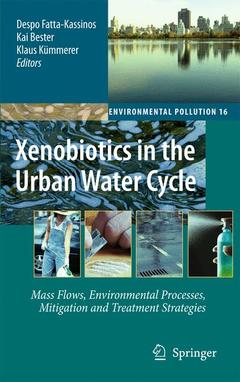Description
Xenobiotics in the Urban Water Cycle, 2010
Mass Flows, Environmental Processes, Mitigation and Treatment Strategies
Environmental Pollution Series, Vol. 16
Coordinators: Fatta-Kassinos Despo, Bester Kai, Kümmerer Klaus
Language: English
Subjects for Xenobiotics in the Urban Water Cycle:
Publication date: 05-2012
507 p. · 15.5x23.5 cm · Paperback
Publication date: 03-2010
507 p. · 15.5x23.5 cm · Hardback
Description
/li>Contents
/li>Biography
/li>Comment
/li>
Despo Fatta-Kassinos received her Diploma in Chemical Engineering from the National Technical University of Athens, Greece and her M.Sc. in Environmental Management from the European Association for Environmental Management and Education (University of Athens, Greece – Joint Research Center, Ispra, Italy). She received her Ph.D. in Chemical Engineering from the National Technical University of Athens, Greece. She is a faculty member of the Department of Civil and Environmental Engineering of the University of Cyprus since 2003. She is the head of GAIA, Laboratory of Environmental Engineering where a number of scientific projects related to the treatment of xenobiotic compounds in aqueous matrices are being realised. She is a reviewer for several national and European funding bodies. Her principal research interests are in the field of water and wastewater treatment systems, monitoring of environmental pollution and environmental risk assessment. The main focus of her research is the development of advanced oxidation and other combined processes for the treatment of wastewater intended for reuse applications.
Kai Bester studied Chemistry and got his diploma (masters) degree from Hamburg University. He finished his PhD in Marine Environmental and Analytical Chemistry at Hamburg University 1995. Kai Bester worked as scientists at RWTH Aachen, EU Institute for Reference Materials and Measurements (EC-JRC-IRMM) Geel, Belgium and University of Duisburg Essen. He achieved Habilitation in 2005 at the university Duisburg Essen. He is currently working at Aalborg University section for Biotechnology, Chemistry and Environmental Engineering as well as Institute for Environmental Analytical Chemistry University Duisburg-Essen. His main focus is fate and effect of xenobiotic compounds (personal care compounds, bactericides, pharmaceuticals, biocides, flame retardants etc.) in aquatic ecosystems and technical applications.
Klaus Kümmererstudied chem




